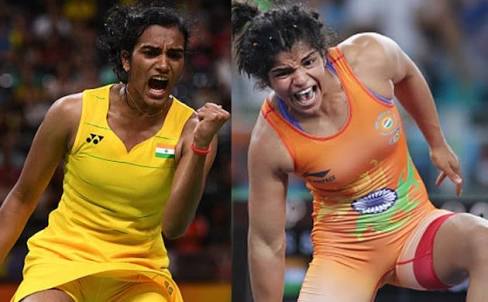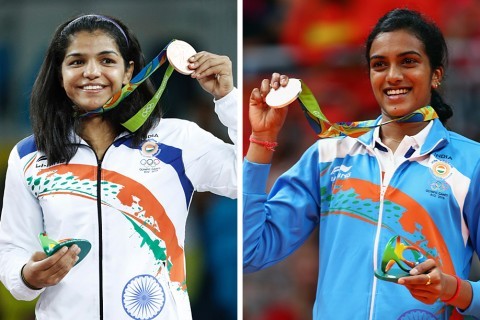The Rio Olympics is almost over. India, the second most populous country in the world, will be coming home with just two medals, one silver and one bronze, unless a medal is won in the last wrestling event on Sunday.
Though India is never known as a great sporting nation, this performance was much poorer than the six medal haul including one gold and two silvers from London, 2012. But the silver lining of Rio 2016 for Indian sports was some sterling performance from women athletes. P V Sindhu won silver in badminton singles and Sakshi Mallik won bronze in 58 kilo gram freestyle wrestling. Dipa Karmarkar, first ever Indian athlete to qualify for Olympic gymnastics missed bronze by a whisker. Another notable performance was that of Lalita Babar, a 10th place finish in the 3000 metre steeplechase.

P V Sindhu (left) and Sakshi Malik
Achievements of these women were extraordinary because India is a country where girls are made sure they are unwelcome even inside the womb. For example, Rohtak district in Haryana state from where the bronze medalist Sakshi Malik comes from has one of the lowest sex ratio in the country with a child sex ratio (0-6 years) of 807 girls for 1000 boys. The national average, though poor, is 919. Illegal female foeticide is very rampant in this part of the country.

Dipa Karmakar -Reuters
In India you won’t see a single girl playing in public grounds. They do not play, not because they do not want, but because of fear of sexual harassment. Parents rarely encourage girls to take up sport in fear of sexual assault and lack of prospects in marriage market for an athlete.
In such a bleak scenario it’s heartening to hear stories of valiant fighters who fought all odds to achieve success like that of Sakshi Malik and Lalita Barbar.
According to Sakshi, locals used to berate her parents when she was growing up, warning them that their daughter would develop puffed-out cauliflower ears, common among wrestlers, and become undesirable to potential husbands. “It hurt a little and I wondered why people said such mean things, especially when I was so young, and made me doubt myself,” she had said.
It’s so weird to see how people can change so suddenly, how they take interest in me now that I’m rising to the top, yet didn’t support me when I was starting out,” she once commented of villagers flocking to take selfies and feed her sweets (after she won medals in Commonwealth and Asian Championships).
In that same interview, she had casually mentioned how without the support of her family, she would probably be married with children by now and with no prospect of a career in sports. “My life is very special compared to my friends’. Some of them study a bit and then do household chores. The married ones are busy taking care of their husbands and babies,” said Sakshi.
Now, as only the fourth Indian woman to win an Olympic medal, Sakshi can put off thinking of marriage for a while longer.
Lalita Babar was born to a family of farmers in the drought hit district of Satara in Maharashtra state. As a child she had to walk or run for several miles to go to school and bring water to the house. Later she was forced to take up running marathons to earn money to make ends meet.

Lalita Babar
PTI Photo by Atul Yadav
With the support of her family, she started running half marathons and full marathons and started earning money for her family. Lalita’s first big earning was Rs 10,000, which she received after winning a 10km road race as a 15-year-old in 2004.
After participating in many national-level tournaments, Lalita took part in the 3000m event at the 2009 Asian Indoor Games in Hanoi, where she bagged the eight place.
In the 2010 Asian Games, she worked with Belarusian coach Nikolai Snesarev, who introduced Lalita to a rather interesting event – the steeplechase.
However, Snesarev left in 2010 and Lalita got back to marathon running. But in 2014, the Belarusian coach returned wanting to train Laita for marathons. However, the Maharashtrian girl was very keen on participating in the steeplechase event.Barely after eight months of vigorous training, Lalita won the bronze medal in the event at the Incheon Asian Games and broke the national record with a timing of 9:35:37.
Then, she won the gold medal at the 2015 Asian Championships with another national record timing and booked her place in the Rio Olympics.
After breaking her own national record for a few more times, she set another national record during the heats of the 3000m steeplechase event at Rio with a timing of 9:19.76.
Lalita Babar’s story is a truly inspirational one for the poor and oppressed women of India.
P V Sindhu, who won the silver in badminton was more fortunate to have sports persons as parents. She could get some good professional training from childhood. As she fought valiantly in finals before losing narrowly to world champion Carolina Marin, it was discovered that Indians were shamefully busy searching Google to find out her caste.

Sakshi (left) and Sindhu Getty images
On International scale, these achievements may be nothing, but these girls showed the severely patriarchal Indian society the power, potential and fighting spirit of the oppressed gender. Conservative men, including political and religious leaders who frowned upon girls wearing short skirts, shorts and other revealing dresses were forced to display pictures of these athletes similarly attired on their Facebook wall proclaiming how proud they are of them. Prime minister Modi, who had once advised parents to plant trees when a girl is born, so that they can easily fund their marriages (pay dowry) by selling the timber, might have been embarrassed as he tweeted his congratulations.
Let us hope that successes of these Indian women in Rio Olympics will help in a small way to make India a more gender equitable country.

“In India you won’t see a single girl playing in public grounds. ”
This is so sad. Little girls cannot play freely for fear of being sexually harassed? No skipping, running, jumping, climbing trees, swimming, group games, team sports for fear of being harmed? An entire country is missing the laughter and joy of nearly half of its children (and it would be more than half but for sex selection abortion).
I meant not in all grounds. Girls may be seen in playing areas of schools and inside apartment complexes and some even in public spaces, if there are elder people or coaches to watch and ensure there is no harassment If there is nobody to watch girls won’t dare to play.
This is still terrible, and I feel it must reflect something relatively new in India. I believe it is more usual for human adults,men and women, to feel protective of children. I wonder how it has become an expected state of affairs that girls in India have to be protected from sexual harassment and how boys and men can once again learn to see girls differently.